Human Interaction with Plants Report
VerifiedAdded on 2020/10/23
|12
|3899
|243
Report
AI Summary
This report delves into the historical and contemporary interactions between humans and plants, examining plant domestication, breeding techniques, and the impacts of global warming on plant diversity. It discusses the advantages and disadvantages of genetic modifications, classical breeding strategies, and environmental strategies to mitigate plant diversity loss. The report concludes with the importance of sustainable practices to enhance plant growth and nutrition.
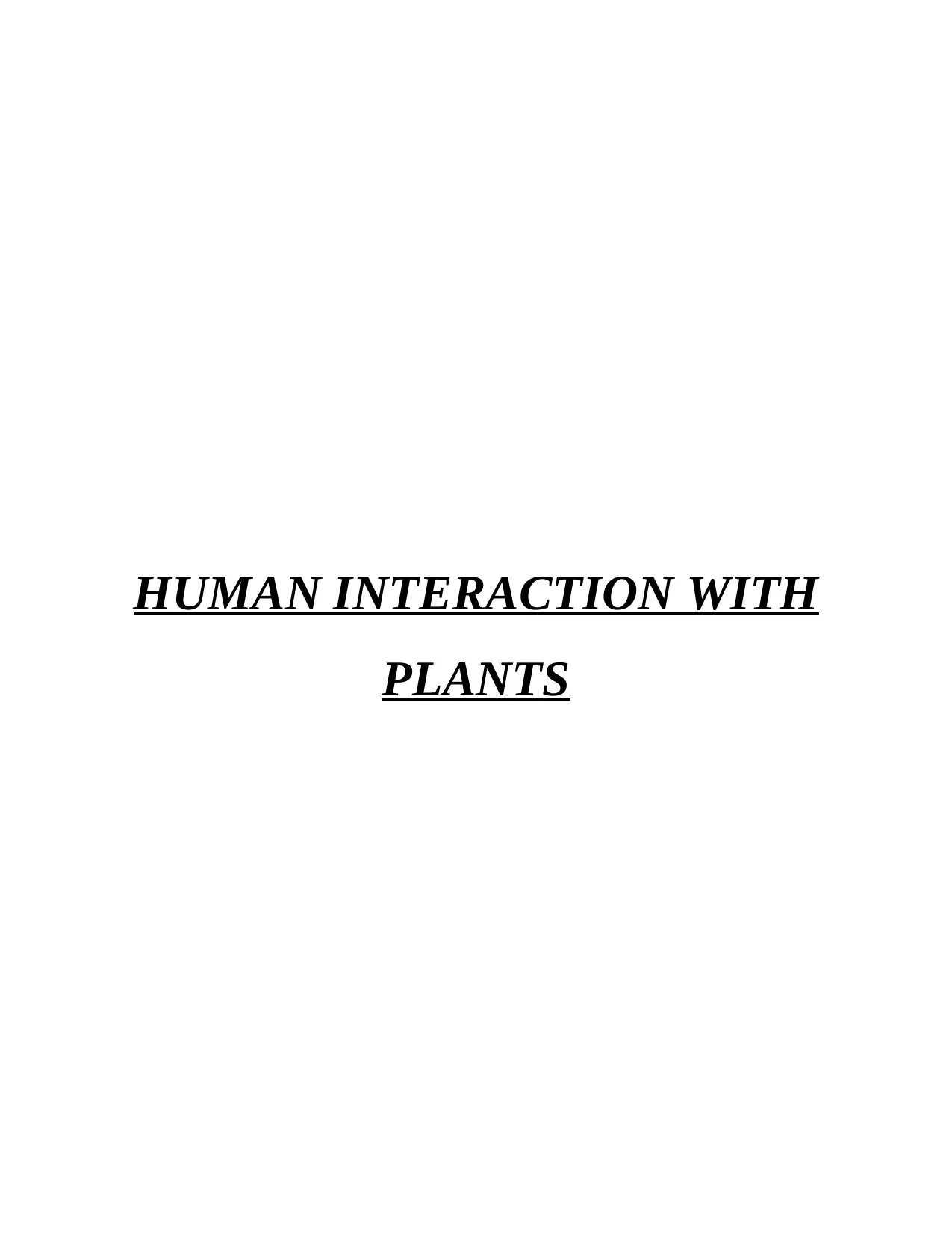
HUMAN INTERACTION WITH
PLANTS
PLANTS
Paraphrase This Document
Need a fresh take? Get an instant paraphrase of this document with our AI Paraphraser
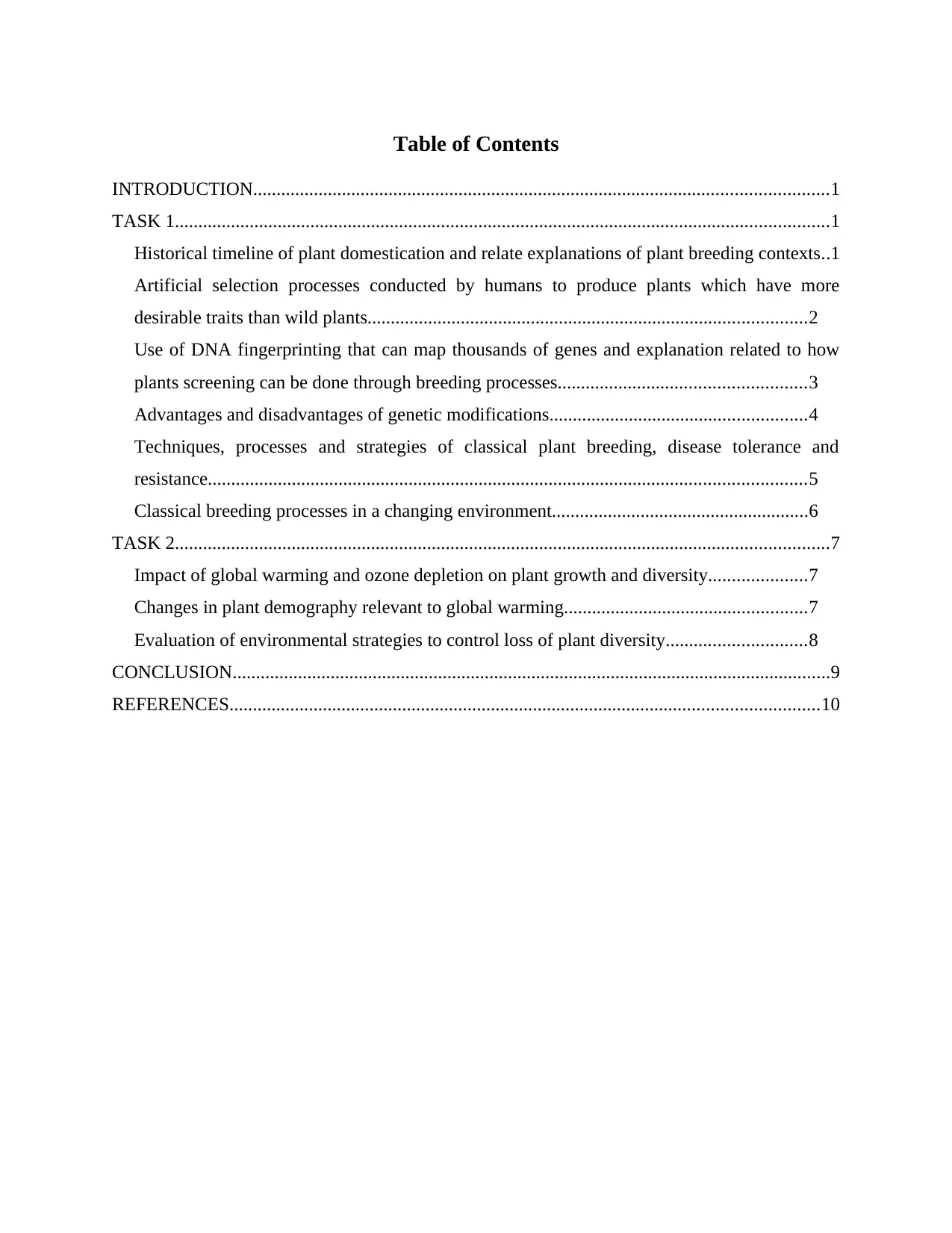
Table of Contents
INTRODUCTION...........................................................................................................................1
TASK 1............................................................................................................................................1
Historical timeline of plant domestication and relate explanations of plant breeding contexts..1
Artificial selection processes conducted by humans to produce plants which have more
desirable traits than wild plants..............................................................................................2
Use of DNA fingerprinting that can map thousands of genes and explanation related to how
plants screening can be done through breeding processes.....................................................3
Advantages and disadvantages of genetic modifications.......................................................4
Techniques, processes and strategies of classical plant breeding, disease tolerance and
resistance................................................................................................................................5
Classical breeding processes in a changing environment.......................................................6
TASK 2............................................................................................................................................7
Impact of global warming and ozone depletion on plant growth and diversity.....................7
Changes in plant demography relevant to global warming....................................................7
Evaluation of environmental strategies to control loss of plant diversity..............................8
CONCLUSION................................................................................................................................9
REFERENCES..............................................................................................................................10
INTRODUCTION...........................................................................................................................1
TASK 1............................................................................................................................................1
Historical timeline of plant domestication and relate explanations of plant breeding contexts..1
Artificial selection processes conducted by humans to produce plants which have more
desirable traits than wild plants..............................................................................................2
Use of DNA fingerprinting that can map thousands of genes and explanation related to how
plants screening can be done through breeding processes.....................................................3
Advantages and disadvantages of genetic modifications.......................................................4
Techniques, processes and strategies of classical plant breeding, disease tolerance and
resistance................................................................................................................................5
Classical breeding processes in a changing environment.......................................................6
TASK 2............................................................................................................................................7
Impact of global warming and ozone depletion on plant growth and diversity.....................7
Changes in plant demography relevant to global warming....................................................7
Evaluation of environmental strategies to control loss of plant diversity..............................8
CONCLUSION................................................................................................................................9
REFERENCES..............................................................................................................................10
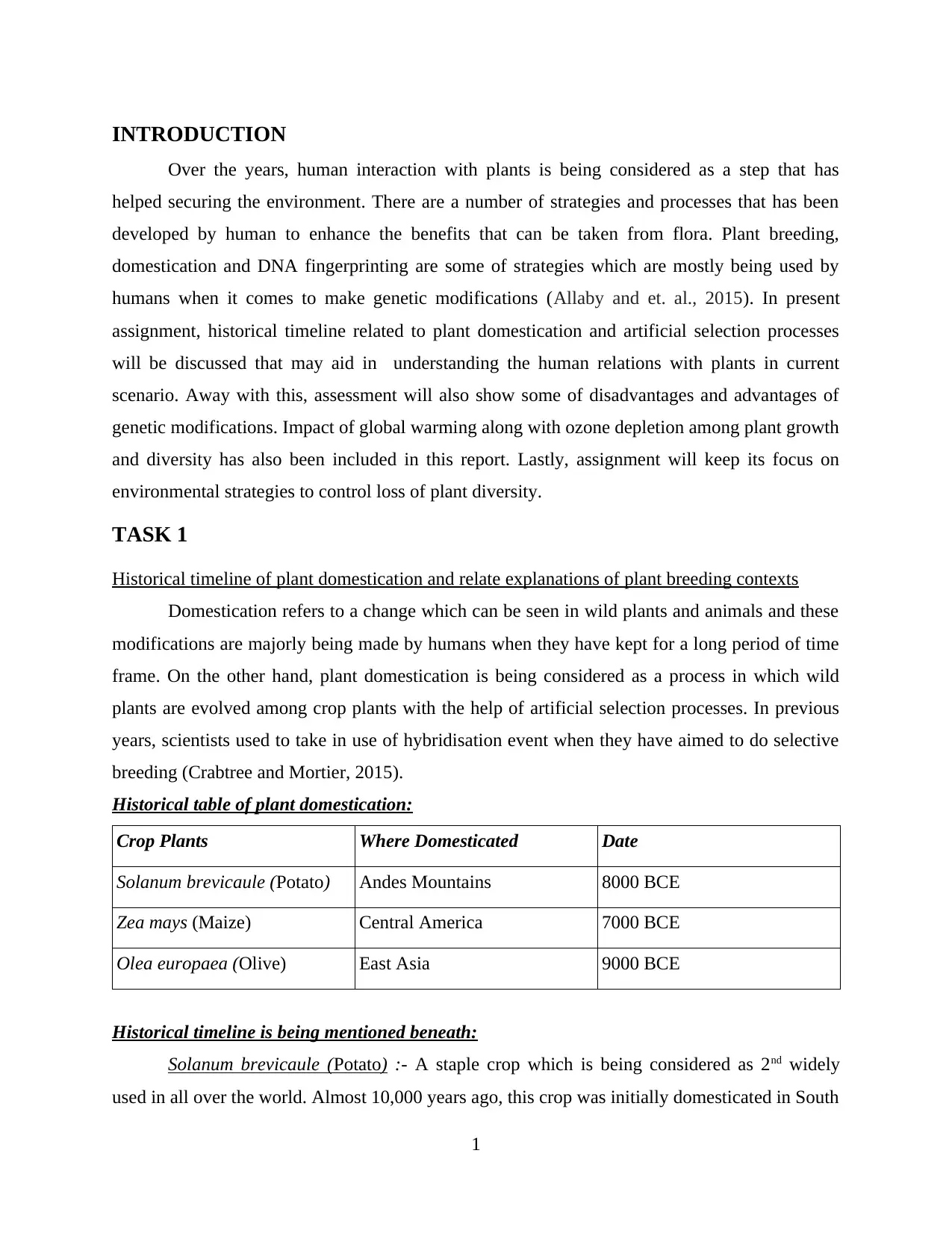
INTRODUCTION
Over the years, human interaction with plants is being considered as a step that has
helped securing the environment. There are a number of strategies and processes that has been
developed by human to enhance the benefits that can be taken from flora. Plant breeding,
domestication and DNA fingerprinting are some of strategies which are mostly being used by
humans when it comes to make genetic modifications (Allaby and et. al., 2015). In present
assignment, historical timeline related to plant domestication and artificial selection processes
will be discussed that may aid in understanding the human relations with plants in current
scenario. Away with this, assessment will also show some of disadvantages and advantages of
genetic modifications. Impact of global warming along with ozone depletion among plant growth
and diversity has also been included in this report. Lastly, assignment will keep its focus on
environmental strategies to control loss of plant diversity.
TASK 1
Historical timeline of plant domestication and relate explanations of plant breeding contexts
Domestication refers to a change which can be seen in wild plants and animals and these
modifications are majorly being made by humans when they have kept for a long period of time
frame. On the other hand, plant domestication is being considered as a process in which wild
plants are evolved among crop plants with the help of artificial selection processes. In previous
years, scientists used to take in use of hybridisation event when they have aimed to do selective
breeding (Crabtree and Mortier, 2015).
Historical table of plant domestication:
Crop Plants Where Domesticated Date
Solanum brevicaule (Potato) Andes Mountains 8000 BCE
Zea mays (Maize) Central America 7000 BCE
Olea europaea (Olive) East Asia 9000 BCE
Historical timeline is being mentioned beneath:
Solanum brevicaule (Potato) :- A staple crop which is being considered as 2nd widely
used in all over the world. Almost 10,000 years ago, this crop was initially domesticated in South
1
Over the years, human interaction with plants is being considered as a step that has
helped securing the environment. There are a number of strategies and processes that has been
developed by human to enhance the benefits that can be taken from flora. Plant breeding,
domestication and DNA fingerprinting are some of strategies which are mostly being used by
humans when it comes to make genetic modifications (Allaby and et. al., 2015). In present
assignment, historical timeline related to plant domestication and artificial selection processes
will be discussed that may aid in understanding the human relations with plants in current
scenario. Away with this, assessment will also show some of disadvantages and advantages of
genetic modifications. Impact of global warming along with ozone depletion among plant growth
and diversity has also been included in this report. Lastly, assignment will keep its focus on
environmental strategies to control loss of plant diversity.
TASK 1
Historical timeline of plant domestication and relate explanations of plant breeding contexts
Domestication refers to a change which can be seen in wild plants and animals and these
modifications are majorly being made by humans when they have kept for a long period of time
frame. On the other hand, plant domestication is being considered as a process in which wild
plants are evolved among crop plants with the help of artificial selection processes. In previous
years, scientists used to take in use of hybridisation event when they have aimed to do selective
breeding (Crabtree and Mortier, 2015).
Historical table of plant domestication:
Crop Plants Where Domesticated Date
Solanum brevicaule (Potato) Andes Mountains 8000 BCE
Zea mays (Maize) Central America 7000 BCE
Olea europaea (Olive) East Asia 9000 BCE
Historical timeline is being mentioned beneath:
Solanum brevicaule (Potato) :- A staple crop which is being considered as 2nd widely
used in all over the world. Almost 10,000 years ago, this crop was initially domesticated in South
1
⊘ This is a preview!⊘
Do you want full access?
Subscribe today to unlock all pages.

Trusted by 1+ million students worldwide
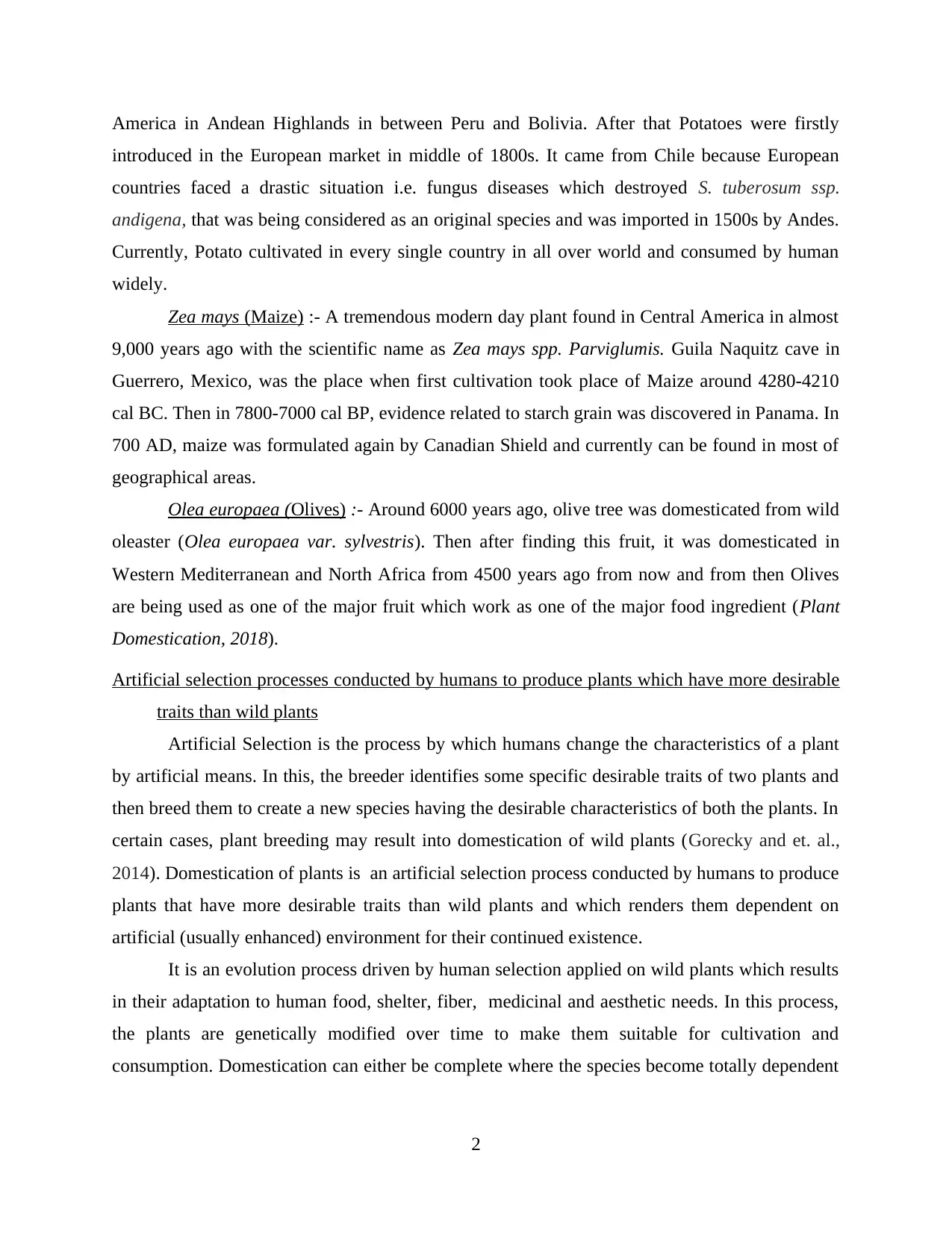
America in Andean Highlands in between Peru and Bolivia. After that Potatoes were firstly
introduced in the European market in middle of 1800s. It came from Chile because European
countries faced a drastic situation i.e. fungus diseases which destroyed S. tuberosum ssp.
andigena, that was being considered as an original species and was imported in 1500s by Andes.
Currently, Potato cultivated in every single country in all over world and consumed by human
widely.
Zea mays (Maize) :- A tremendous modern day plant found in Central America in almost
9,000 years ago with the scientific name as Zea mays spp. Parviglumis. Guila Naquitz cave in
Guerrero, Mexico, was the place when first cultivation took place of Maize around 4280-4210
cal BC. Then in 7800-7000 cal BP, evidence related to starch grain was discovered in Panama. In
700 AD, maize was formulated again by Canadian Shield and currently can be found in most of
geographical areas.
Olea europaea (Olives) :- Around 6000 years ago, olive tree was domesticated from wild
oleaster (Olea europaea var. sylvestris). Then after finding this fruit, it was domesticated in
Western Mediterranean and North Africa from 4500 years ago from now and from then Olives
are being used as one of the major fruit which work as one of the major food ingredient (Plant
Domestication, 2018).
Artificial selection processes conducted by humans to produce plants which have more desirable
traits than wild plants
Artificial Selection is the process by which humans change the characteristics of a plant
by artificial means. In this, the breeder identifies some specific desirable traits of two plants and
then breed them to create a new species having the desirable characteristics of both the plants. In
certain cases, plant breeding may result into domestication of wild plants (Gorecky and et. al.,
2014). Domestication of plants is an artificial selection process conducted by humans to produce
plants that have more desirable traits than wild plants and which renders them dependent on
artificial (usually enhanced) environment for their continued existence.
It is an evolution process driven by human selection applied on wild plants which results
in their adaptation to human food, shelter, fiber, medicinal and aesthetic needs. In this process,
the plants are genetically modified over time to make them suitable for cultivation and
consumption. Domestication can either be complete where the species become totally dependent
2
introduced in the European market in middle of 1800s. It came from Chile because European
countries faced a drastic situation i.e. fungus diseases which destroyed S. tuberosum ssp.
andigena, that was being considered as an original species and was imported in 1500s by Andes.
Currently, Potato cultivated in every single country in all over world and consumed by human
widely.
Zea mays (Maize) :- A tremendous modern day plant found in Central America in almost
9,000 years ago with the scientific name as Zea mays spp. Parviglumis. Guila Naquitz cave in
Guerrero, Mexico, was the place when first cultivation took place of Maize around 4280-4210
cal BC. Then in 7800-7000 cal BP, evidence related to starch grain was discovered in Panama. In
700 AD, maize was formulated again by Canadian Shield and currently can be found in most of
geographical areas.
Olea europaea (Olives) :- Around 6000 years ago, olive tree was domesticated from wild
oleaster (Olea europaea var. sylvestris). Then after finding this fruit, it was domesticated in
Western Mediterranean and North Africa from 4500 years ago from now and from then Olives
are being used as one of the major fruit which work as one of the major food ingredient (Plant
Domestication, 2018).
Artificial selection processes conducted by humans to produce plants which have more desirable
traits than wild plants
Artificial Selection is the process by which humans change the characteristics of a plant
by artificial means. In this, the breeder identifies some specific desirable traits of two plants and
then breed them to create a new species having the desirable characteristics of both the plants. In
certain cases, plant breeding may result into domestication of wild plants (Gorecky and et. al.,
2014). Domestication of plants is an artificial selection process conducted by humans to produce
plants that have more desirable traits than wild plants and which renders them dependent on
artificial (usually enhanced) environment for their continued existence.
It is an evolution process driven by human selection applied on wild plants which results
in their adaptation to human food, shelter, fiber, medicinal and aesthetic needs. In this process,
the plants are genetically modified over time to make them suitable for cultivation and
consumption. Domestication can either be complete where the species become totally dependent
2
Paraphrase This Document
Need a fresh take? Get an instant paraphrase of this document with our AI Paraphraser
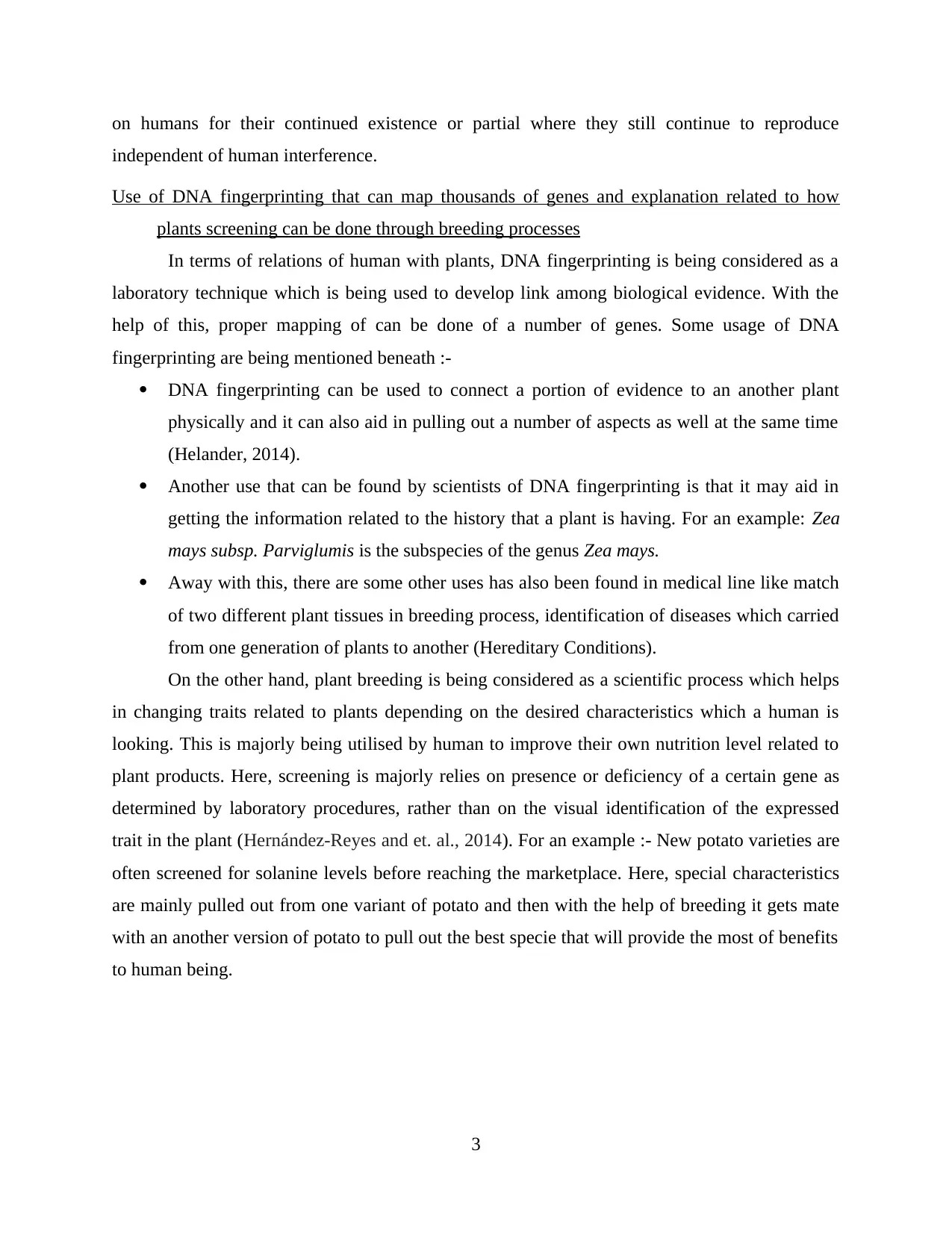
on humans for their continued existence or partial where they still continue to reproduce
independent of human interference.
Use of DNA fingerprinting that can map thousands of genes and explanation related to how
plants screening can be done through breeding processes
In terms of relations of human with plants, DNA fingerprinting is being considered as a
laboratory technique which is being used to develop link among biological evidence. With the
help of this, proper mapping of can be done of a number of genes. Some usage of DNA
fingerprinting are being mentioned beneath :-
DNA fingerprinting can be used to connect a portion of evidence to an another plant
physically and it can also aid in pulling out a number of aspects as well at the same time
(Helander, 2014).
Another use that can be found by scientists of DNA fingerprinting is that it may aid in
getting the information related to the history that a plant is having. For an example: Zea
mays subsp. Parviglumis is the subspecies of the genus Zea mays.
Away with this, there are some other uses has also been found in medical line like match
of two different plant tissues in breeding process, identification of diseases which carried
from one generation of plants to another (Hereditary Conditions).
On the other hand, plant breeding is being considered as a scientific process which helps
in changing traits related to plants depending on the desired characteristics which a human is
looking. This is majorly being utilised by human to improve their own nutrition level related to
plant products. Here, screening is majorly relies on presence or deficiency of a certain gene as
determined by laboratory procedures, rather than on the visual identification of the expressed
trait in the plant (Hernández‐Reyes and et. al., 2014). For an example :- New potato varieties are
often screened for solanine levels before reaching the marketplace. Here, special characteristics
are mainly pulled out from one variant of potato and then with the help of breeding it gets mate
with an another version of potato to pull out the best specie that will provide the most of benefits
to human being.
3
independent of human interference.
Use of DNA fingerprinting that can map thousands of genes and explanation related to how
plants screening can be done through breeding processes
In terms of relations of human with plants, DNA fingerprinting is being considered as a
laboratory technique which is being used to develop link among biological evidence. With the
help of this, proper mapping of can be done of a number of genes. Some usage of DNA
fingerprinting are being mentioned beneath :-
DNA fingerprinting can be used to connect a portion of evidence to an another plant
physically and it can also aid in pulling out a number of aspects as well at the same time
(Helander, 2014).
Another use that can be found by scientists of DNA fingerprinting is that it may aid in
getting the information related to the history that a plant is having. For an example: Zea
mays subsp. Parviglumis is the subspecies of the genus Zea mays.
Away with this, there are some other uses has also been found in medical line like match
of two different plant tissues in breeding process, identification of diseases which carried
from one generation of plants to another (Hereditary Conditions).
On the other hand, plant breeding is being considered as a scientific process which helps
in changing traits related to plants depending on the desired characteristics which a human is
looking. This is majorly being utilised by human to improve their own nutrition level related to
plant products. Here, screening is majorly relies on presence or deficiency of a certain gene as
determined by laboratory procedures, rather than on the visual identification of the expressed
trait in the plant (Hernández‐Reyes and et. al., 2014). For an example :- New potato varieties are
often screened for solanine levels before reaching the marketplace. Here, special characteristics
are mainly pulled out from one variant of potato and then with the help of breeding it gets mate
with an another version of potato to pull out the best specie that will provide the most of benefits
to human being.
3
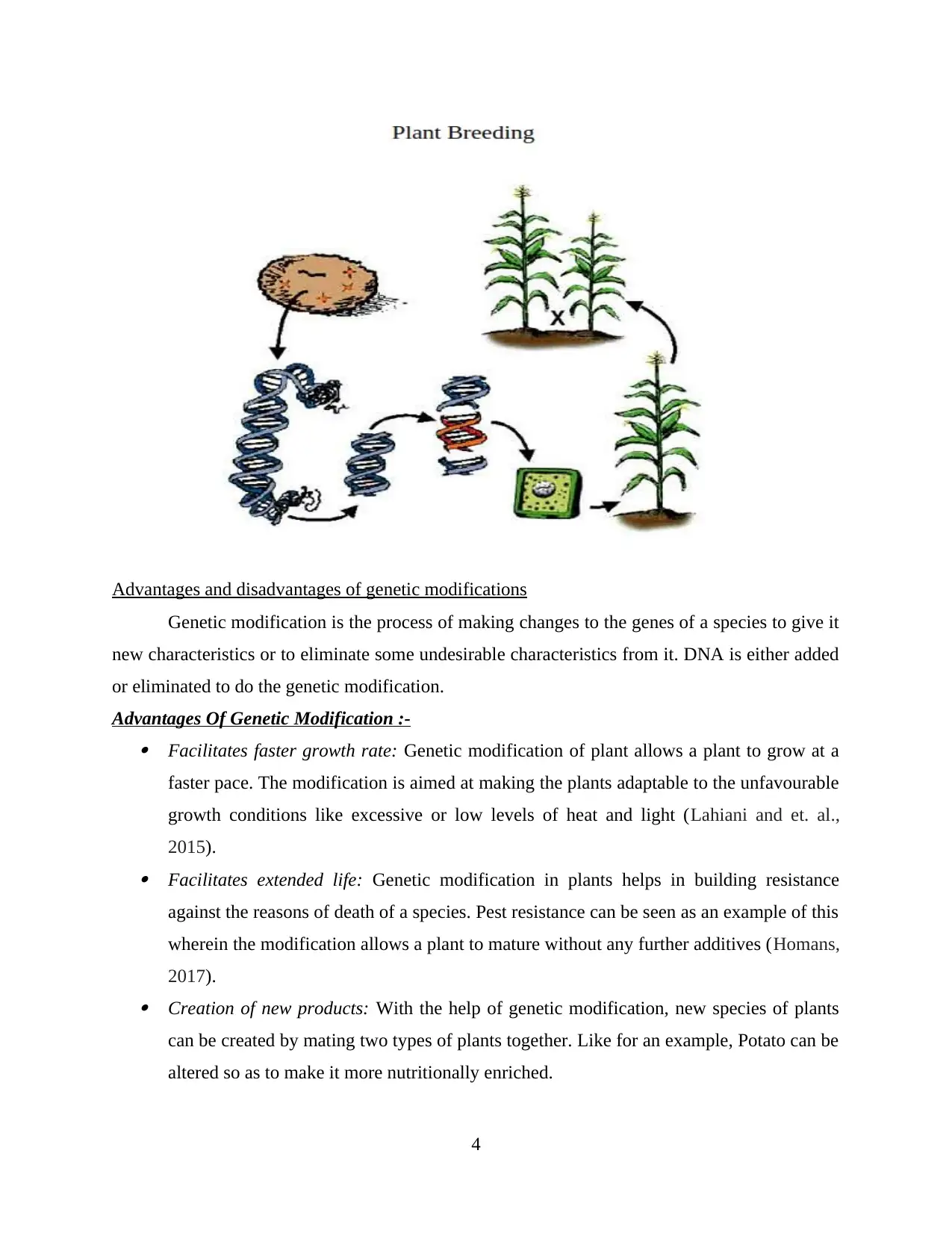
Advantages and disadvantages of genetic modifications
Genetic modification is the process of making changes to the genes of a species to give it
new characteristics or to eliminate some undesirable characteristics from it. DNA is either added
or eliminated to do the genetic modification.
Advantages Of Genetic Modification :- Facilitates faster growth rate: Genetic modification of plant allows a plant to grow at a
faster pace. The modification is aimed at making the plants adaptable to the unfavourable
growth conditions like excessive or low levels of heat and light (Lahiani and et. al.,
2015). Facilitates extended life: Genetic modification in plants helps in building resistance
against the reasons of death of a species. Pest resistance can be seen as an example of this
wherein the modification allows a plant to mature without any further additives (Homans,
2017). Creation of new products: With the help of genetic modification, new species of plants
can be created by mating two types of plants together. Like for an example, Potato can be
altered so as to make it more nutritionally enriched.
4
Genetic modification is the process of making changes to the genes of a species to give it
new characteristics or to eliminate some undesirable characteristics from it. DNA is either added
or eliminated to do the genetic modification.
Advantages Of Genetic Modification :- Facilitates faster growth rate: Genetic modification of plant allows a plant to grow at a
faster pace. The modification is aimed at making the plants adaptable to the unfavourable
growth conditions like excessive or low levels of heat and light (Lahiani and et. al.,
2015). Facilitates extended life: Genetic modification in plants helps in building resistance
against the reasons of death of a species. Pest resistance can be seen as an example of this
wherein the modification allows a plant to mature without any further additives (Homans,
2017). Creation of new products: With the help of genetic modification, new species of plants
can be created by mating two types of plants together. Like for an example, Potato can be
altered so as to make it more nutritionally enriched.
4
⊘ This is a preview!⊘
Do you want full access?
Subscribe today to unlock all pages.

Trusted by 1+ million students worldwide
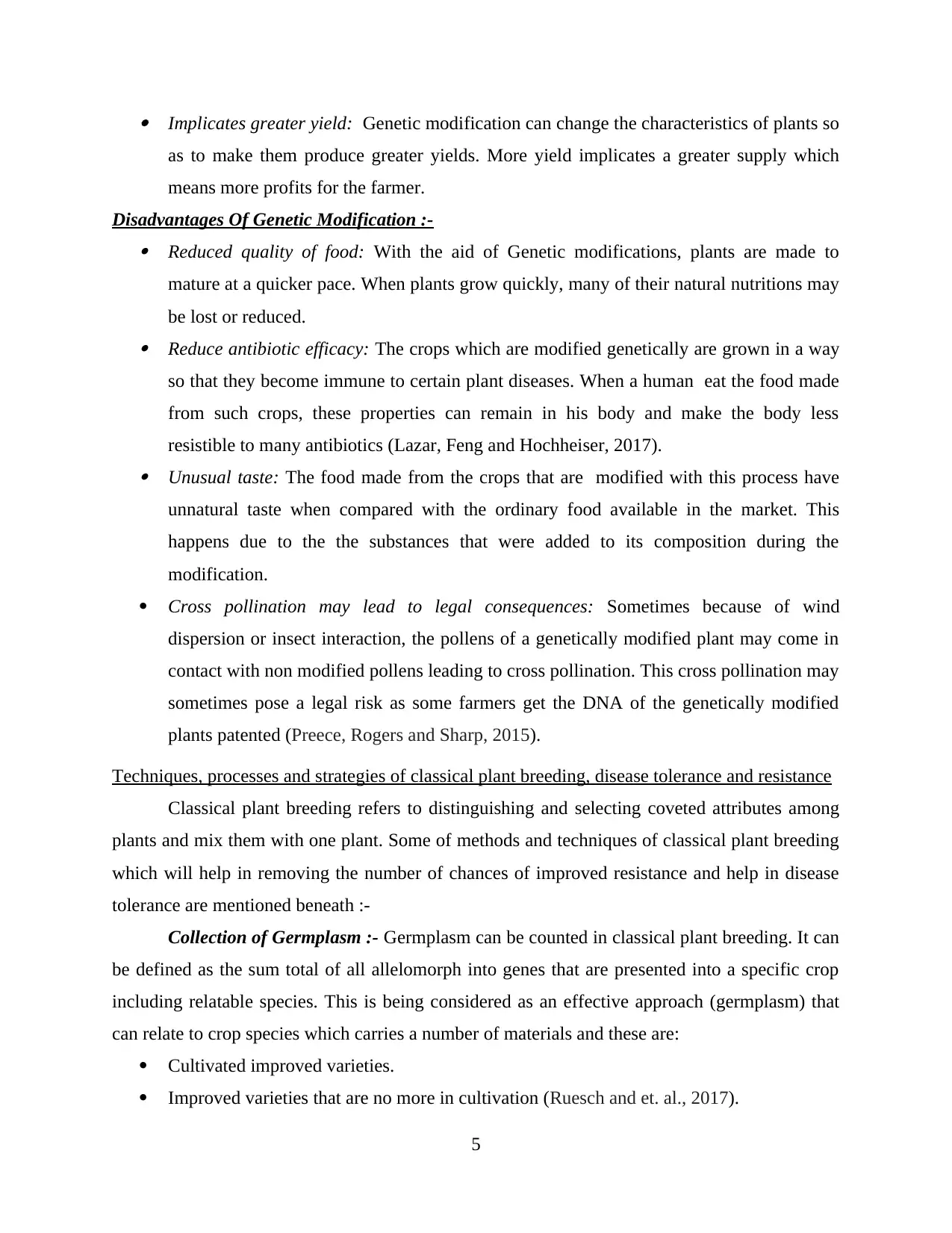
Implicates greater yield: Genetic modification can change the characteristics of plants so
as to make them produce greater yields. More yield implicates a greater supply which
means more profits for the farmer.
Disadvantages Of Genetic Modification :- Reduced quality of food: With the aid of Genetic modifications, plants are made to
mature at a quicker pace. When plants grow quickly, many of their natural nutritions may
be lost or reduced. Reduce antibiotic efficacy: The crops which are modified genetically are grown in a way
so that they become immune to certain plant diseases. When a human eat the food made
from such crops, these properties can remain in his body and make the body less
resistible to many antibiotics (Lazar, Feng and Hochheiser, 2017). Unusual taste: The food made from the crops that are modified with this process have
unnatural taste when compared with the ordinary food available in the market. This
happens due to the the substances that were added to its composition during the
modification.
Cross pollination may lead to legal consequences: Sometimes because of wind
dispersion or insect interaction, the pollens of a genetically modified plant may come in
contact with non modified pollens leading to cross pollination. This cross pollination may
sometimes pose a legal risk as some farmers get the DNA of the genetically modified
plants patented (Preece, Rogers and Sharp, 2015).
Techniques, processes and strategies of classical plant breeding, disease tolerance and resistance
Classical plant breeding refers to distinguishing and selecting coveted attributes among
plants and mix them with one plant. Some of methods and techniques of classical plant breeding
which will help in removing the number of chances of improved resistance and help in disease
tolerance are mentioned beneath :-
Collection of Germplasm :- Germplasm can be counted in classical plant breeding. It can
be defined as the sum total of all allelomorph into genes that are presented into a specific crop
including relatable species. This is being considered as an effective approach (germplasm) that
can relate to crop species which carries a number of materials and these are:
Cultivated improved varieties.
Improved varieties that are no more in cultivation (Ruesch and et. al., 2017).
5
as to make them produce greater yields. More yield implicates a greater supply which
means more profits for the farmer.
Disadvantages Of Genetic Modification :- Reduced quality of food: With the aid of Genetic modifications, plants are made to
mature at a quicker pace. When plants grow quickly, many of their natural nutritions may
be lost or reduced. Reduce antibiotic efficacy: The crops which are modified genetically are grown in a way
so that they become immune to certain plant diseases. When a human eat the food made
from such crops, these properties can remain in his body and make the body less
resistible to many antibiotics (Lazar, Feng and Hochheiser, 2017). Unusual taste: The food made from the crops that are modified with this process have
unnatural taste when compared with the ordinary food available in the market. This
happens due to the the substances that were added to its composition during the
modification.
Cross pollination may lead to legal consequences: Sometimes because of wind
dispersion or insect interaction, the pollens of a genetically modified plant may come in
contact with non modified pollens leading to cross pollination. This cross pollination may
sometimes pose a legal risk as some farmers get the DNA of the genetically modified
plants patented (Preece, Rogers and Sharp, 2015).
Techniques, processes and strategies of classical plant breeding, disease tolerance and resistance
Classical plant breeding refers to distinguishing and selecting coveted attributes among
plants and mix them with one plant. Some of methods and techniques of classical plant breeding
which will help in removing the number of chances of improved resistance and help in disease
tolerance are mentioned beneath :-
Collection of Germplasm :- Germplasm can be counted in classical plant breeding. It can
be defined as the sum total of all allelomorph into genes that are presented into a specific crop
including relatable species. This is being considered as an effective approach (germplasm) that
can relate to crop species which carries a number of materials and these are:
Cultivated improved varieties.
Improved varieties that are no more in cultivation (Ruesch and et. al., 2017).
5
Paraphrase This Document
Need a fresh take? Get an instant paraphrase of this document with our AI Paraphraser
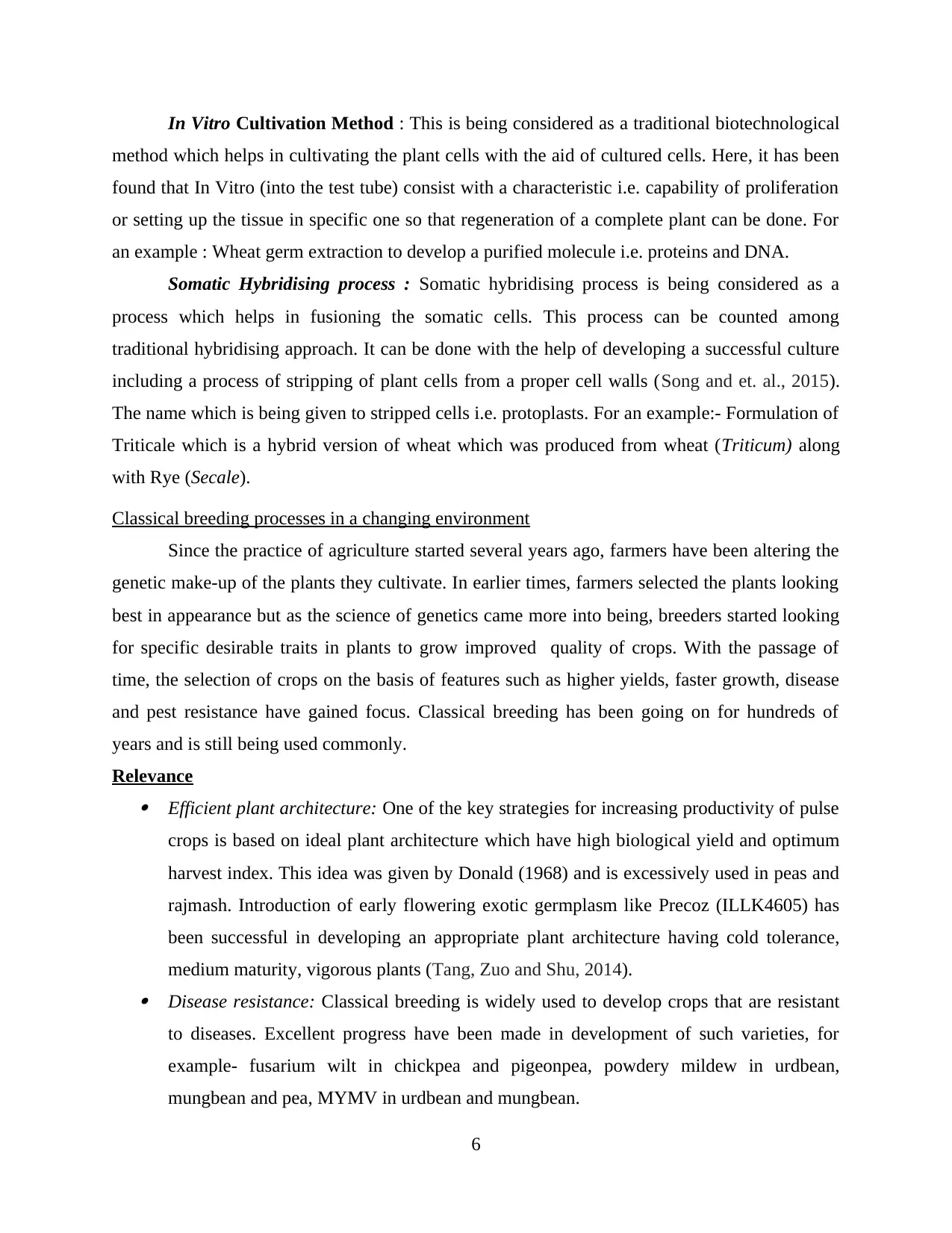
In Vitro Cultivation Method : This is being considered as a traditional biotechnological
method which helps in cultivating the plant cells with the aid of cultured cells. Here, it has been
found that In Vitro (into the test tube) consist with a characteristic i.e. capability of proliferation
or setting up the tissue in specific one so that regeneration of a complete plant can be done. For
an example : Wheat germ extraction to develop a purified molecule i.e. proteins and DNA.
Somatic Hybridising process : Somatic hybridising process is being considered as a
process which helps in fusioning the somatic cells. This process can be counted among
traditional hybridising approach. It can be done with the help of developing a successful culture
including a process of stripping of plant cells from a proper cell walls (Song and et. al., 2015).
The name which is being given to stripped cells i.e. protoplasts. For an example:- Formulation of
Triticale which is a hybrid version of wheat which was produced from wheat (Triticum) along
with Rye (Secale).
Classical breeding processes in a changing environment
Since the practice of agriculture started several years ago, farmers have been altering the
genetic make-up of the plants they cultivate. In earlier times, farmers selected the plants looking
best in appearance but as the science of genetics came more into being, breeders started looking
for specific desirable traits in plants to grow improved quality of crops. With the passage of
time, the selection of crops on the basis of features such as higher yields, faster growth, disease
and pest resistance have gained focus. Classical breeding has been going on for hundreds of
years and is still being used commonly.
Relevance Efficient plant architecture: One of the key strategies for increasing productivity of pulse
crops is based on ideal plant architecture which have high biological yield and optimum
harvest index. This idea was given by Donald (1968) and is excessively used in peas and
rajmash. Introduction of early flowering exotic germplasm like Precoz (ILLK4605) has
been successful in developing an appropriate plant architecture having cold tolerance,
medium maturity, vigorous plants (Tang, Zuo and Shu, 2014). Disease resistance: Classical breeding is widely used to develop crops that are resistant
to diseases. Excellent progress have been made in development of such varieties, for
example- fusarium wilt in chickpea and pigeonpea, powdery mildew in urdbean,
mungbean and pea, MYMV in urdbean and mungbean.
6
method which helps in cultivating the plant cells with the aid of cultured cells. Here, it has been
found that In Vitro (into the test tube) consist with a characteristic i.e. capability of proliferation
or setting up the tissue in specific one so that regeneration of a complete plant can be done. For
an example : Wheat germ extraction to develop a purified molecule i.e. proteins and DNA.
Somatic Hybridising process : Somatic hybridising process is being considered as a
process which helps in fusioning the somatic cells. This process can be counted among
traditional hybridising approach. It can be done with the help of developing a successful culture
including a process of stripping of plant cells from a proper cell walls (Song and et. al., 2015).
The name which is being given to stripped cells i.e. protoplasts. For an example:- Formulation of
Triticale which is a hybrid version of wheat which was produced from wheat (Triticum) along
with Rye (Secale).
Classical breeding processes in a changing environment
Since the practice of agriculture started several years ago, farmers have been altering the
genetic make-up of the plants they cultivate. In earlier times, farmers selected the plants looking
best in appearance but as the science of genetics came more into being, breeders started looking
for specific desirable traits in plants to grow improved quality of crops. With the passage of
time, the selection of crops on the basis of features such as higher yields, faster growth, disease
and pest resistance have gained focus. Classical breeding has been going on for hundreds of
years and is still being used commonly.
Relevance Efficient plant architecture: One of the key strategies for increasing productivity of pulse
crops is based on ideal plant architecture which have high biological yield and optimum
harvest index. This idea was given by Donald (1968) and is excessively used in peas and
rajmash. Introduction of early flowering exotic germplasm like Precoz (ILLK4605) has
been successful in developing an appropriate plant architecture having cold tolerance,
medium maturity, vigorous plants (Tang, Zuo and Shu, 2014). Disease resistance: Classical breeding is widely used to develop crops that are resistant
to diseases. Excellent progress have been made in development of such varieties, for
example- fusarium wilt in chickpea and pigeonpea, powdery mildew in urdbean,
mungbean and pea, MYMV in urdbean and mungbean.
6
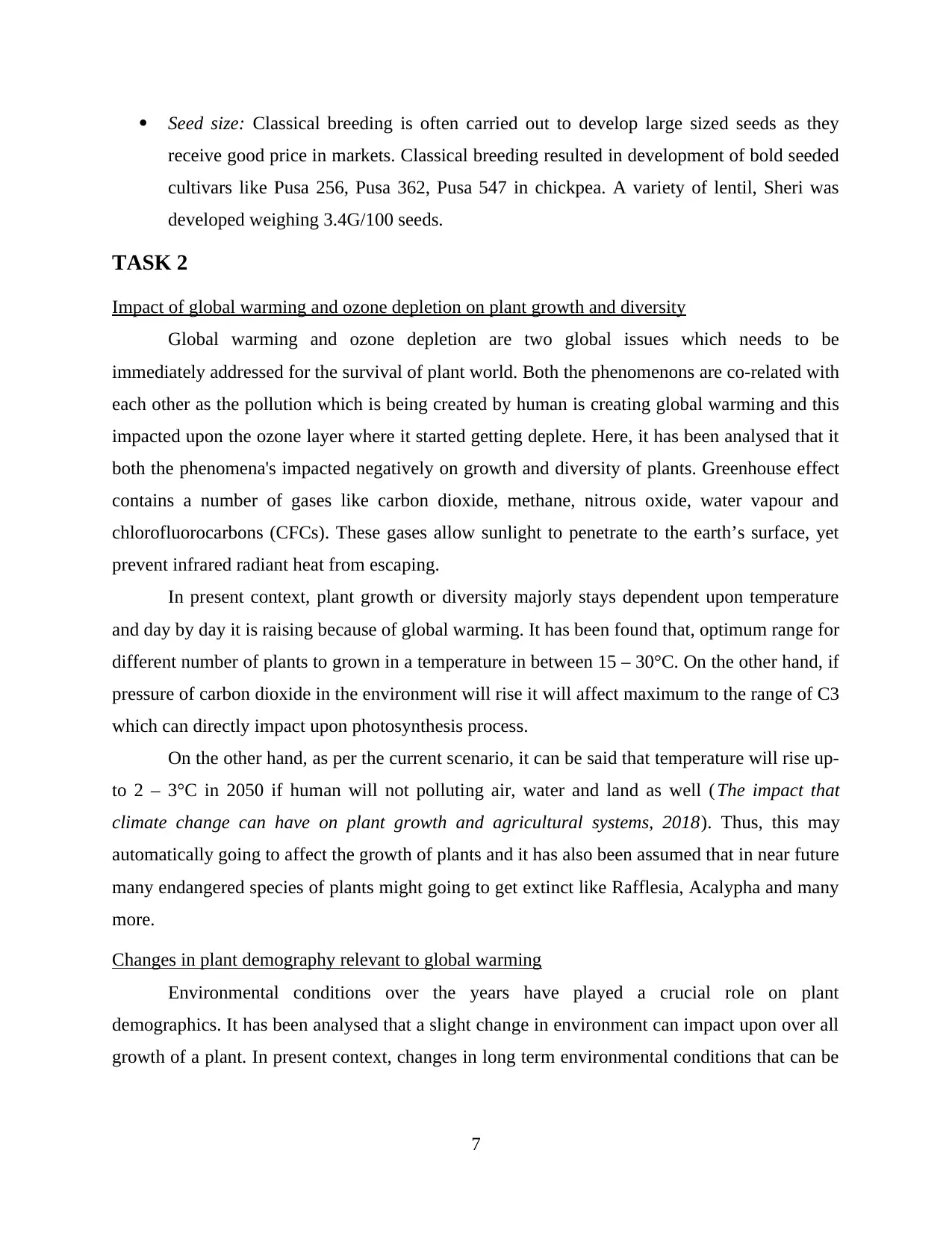
Seed size: Classical breeding is often carried out to develop large sized seeds as they
receive good price in markets. Classical breeding resulted in development of bold seeded
cultivars like Pusa 256, Pusa 362, Pusa 547 in chickpea. A variety of lentil, Sheri was
developed weighing 3.4G/100 seeds.
TASK 2
Impact of global warming and ozone depletion on plant growth and diversity
Global warming and ozone depletion are two global issues which needs to be
immediately addressed for the survival of plant world. Both the phenomenons are co-related with
each other as the pollution which is being created by human is creating global warming and this
impacted upon the ozone layer where it started getting deplete. Here, it has been analysed that it
both the phenomena's impacted negatively on growth and diversity of plants. Greenhouse effect
contains a number of gases like carbon dioxide, methane, nitrous oxide, water vapour and
chlorofluorocarbons (CFCs). These gases allow sunlight to penetrate to the earth’s surface, yet
prevent infrared radiant heat from escaping.
In present context, plant growth or diversity majorly stays dependent upon temperature
and day by day it is raising because of global warming. It has been found that, optimum range for
different number of plants to grown in a temperature in between 15 – 30°C. On the other hand, if
pressure of carbon dioxide in the environment will rise it will affect maximum to the range of C3
which can directly impact upon photosynthesis process.
On the other hand, as per the current scenario, it can be said that temperature will rise up-
to 2 – 3°C in 2050 if human will not polluting air, water and land as well ( The impact that
climate change can have on plant growth and agricultural systems, 2018). Thus, this may
automatically going to affect the growth of plants and it has also been assumed that in near future
many endangered species of plants might going to get extinct like Rafflesia, Acalypha and many
more.
Changes in plant demography relevant to global warming
Environmental conditions over the years have played a crucial role on plant
demographics. It has been analysed that a slight change in environment can impact upon over all
growth of a plant. In present context, changes in long term environmental conditions that can be
7
receive good price in markets. Classical breeding resulted in development of bold seeded
cultivars like Pusa 256, Pusa 362, Pusa 547 in chickpea. A variety of lentil, Sheri was
developed weighing 3.4G/100 seeds.
TASK 2
Impact of global warming and ozone depletion on plant growth and diversity
Global warming and ozone depletion are two global issues which needs to be
immediately addressed for the survival of plant world. Both the phenomenons are co-related with
each other as the pollution which is being created by human is creating global warming and this
impacted upon the ozone layer where it started getting deplete. Here, it has been analysed that it
both the phenomena's impacted negatively on growth and diversity of plants. Greenhouse effect
contains a number of gases like carbon dioxide, methane, nitrous oxide, water vapour and
chlorofluorocarbons (CFCs). These gases allow sunlight to penetrate to the earth’s surface, yet
prevent infrared radiant heat from escaping.
In present context, plant growth or diversity majorly stays dependent upon temperature
and day by day it is raising because of global warming. It has been found that, optimum range for
different number of plants to grown in a temperature in between 15 – 30°C. On the other hand, if
pressure of carbon dioxide in the environment will rise it will affect maximum to the range of C3
which can directly impact upon photosynthesis process.
On the other hand, as per the current scenario, it can be said that temperature will rise up-
to 2 – 3°C in 2050 if human will not polluting air, water and land as well ( The impact that
climate change can have on plant growth and agricultural systems, 2018). Thus, this may
automatically going to affect the growth of plants and it has also been assumed that in near future
many endangered species of plants might going to get extinct like Rafflesia, Acalypha and many
more.
Changes in plant demography relevant to global warming
Environmental conditions over the years have played a crucial role on plant
demographics. It has been analysed that a slight change in environment can impact upon over all
growth of a plant. In present context, changes in long term environmental conditions that can be
7
⊘ This is a preview!⊘
Do you want full access?
Subscribe today to unlock all pages.

Trusted by 1+ million students worldwide
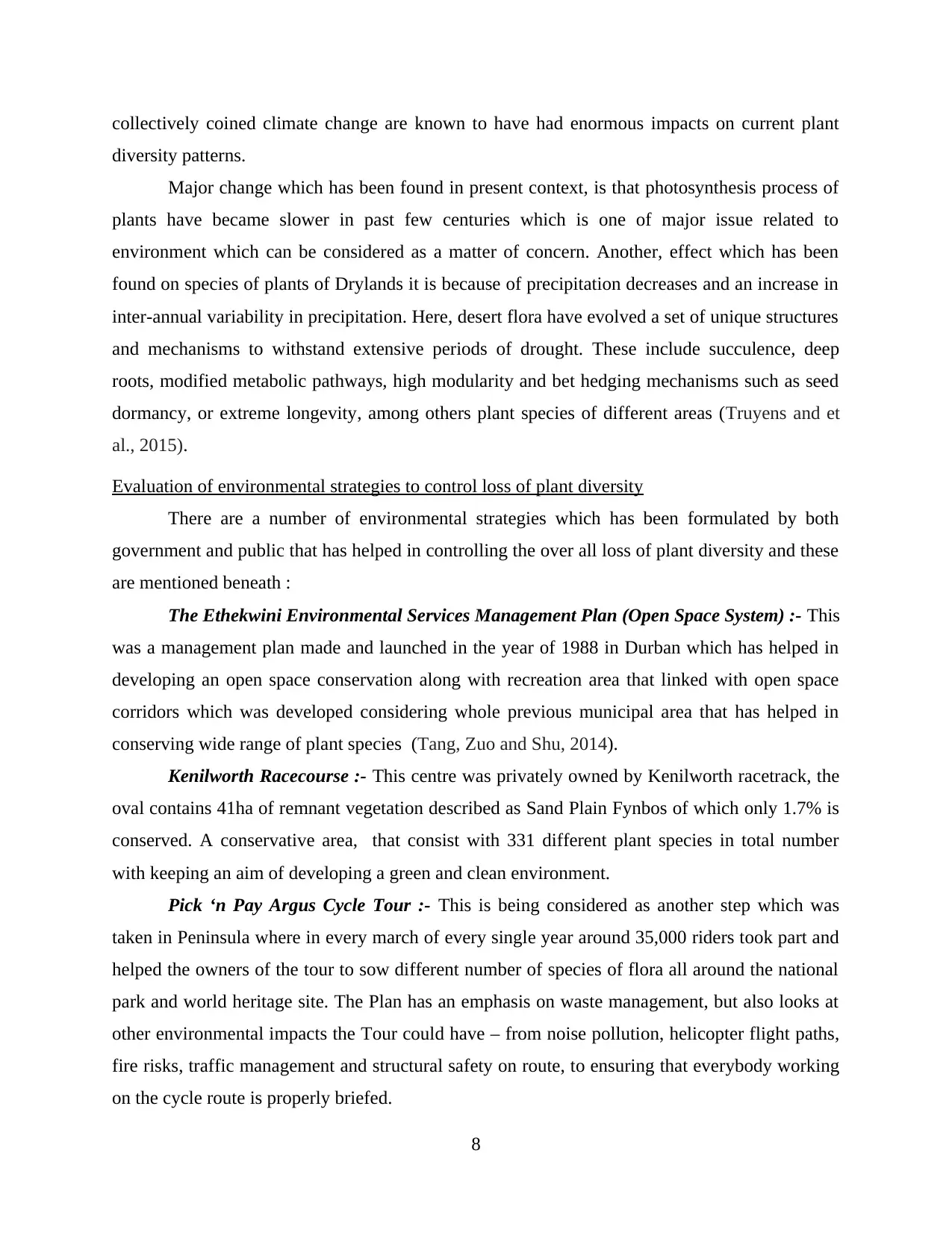
collectively coined climate change are known to have had enormous impacts on current plant
diversity patterns.
Major change which has been found in present context, is that photosynthesis process of
plants have became slower in past few centuries which is one of major issue related to
environment which can be considered as a matter of concern. Another, effect which has been
found on species of plants of Drylands it is because of precipitation decreases and an increase in
inter-annual variability in precipitation. Here, desert flora have evolved a set of unique structures
and mechanisms to withstand extensive periods of drought. These include succulence, deep
roots, modified metabolic pathways, high modularity and bet hedging mechanisms such as seed
dormancy, or extreme longevity, among others plant species of different areas (Truyens and et
al., 2015).
Evaluation of environmental strategies to control loss of plant diversity
There are a number of environmental strategies which has been formulated by both
government and public that has helped in controlling the over all loss of plant diversity and these
are mentioned beneath :
The Ethekwini Environmental Services Management Plan (Open Space System) :- This
was a management plan made and launched in the year of 1988 in Durban which has helped in
developing an open space conservation along with recreation area that linked with open space
corridors which was developed considering whole previous municipal area that has helped in
conserving wide range of plant species (Tang, Zuo and Shu, 2014).
Kenilworth Racecourse :- This centre was privately owned by Kenilworth racetrack, the
oval contains 41ha of remnant vegetation described as Sand Plain Fynbos of which only 1.7% is
conserved. A conservative area, that consist with 331 different plant species in total number
with keeping an aim of developing a green and clean environment.
Pick ‘n Pay Argus Cycle Tour :- This is being considered as another step which was
taken in Peninsula where in every march of every single year around 35,000 riders took part and
helped the owners of the tour to sow different number of species of flora all around the national
park and world heritage site. The Plan has an emphasis on waste management, but also looks at
other environmental impacts the Tour could have – from noise pollution, helicopter flight paths,
fire risks, traffic management and structural safety on route, to ensuring that everybody working
on the cycle route is properly briefed.
8
diversity patterns.
Major change which has been found in present context, is that photosynthesis process of
plants have became slower in past few centuries which is one of major issue related to
environment which can be considered as a matter of concern. Another, effect which has been
found on species of plants of Drylands it is because of precipitation decreases and an increase in
inter-annual variability in precipitation. Here, desert flora have evolved a set of unique structures
and mechanisms to withstand extensive periods of drought. These include succulence, deep
roots, modified metabolic pathways, high modularity and bet hedging mechanisms such as seed
dormancy, or extreme longevity, among others plant species of different areas (Truyens and et
al., 2015).
Evaluation of environmental strategies to control loss of plant diversity
There are a number of environmental strategies which has been formulated by both
government and public that has helped in controlling the over all loss of plant diversity and these
are mentioned beneath :
The Ethekwini Environmental Services Management Plan (Open Space System) :- This
was a management plan made and launched in the year of 1988 in Durban which has helped in
developing an open space conservation along with recreation area that linked with open space
corridors which was developed considering whole previous municipal area that has helped in
conserving wide range of plant species (Tang, Zuo and Shu, 2014).
Kenilworth Racecourse :- This centre was privately owned by Kenilworth racetrack, the
oval contains 41ha of remnant vegetation described as Sand Plain Fynbos of which only 1.7% is
conserved. A conservative area, that consist with 331 different plant species in total number
with keeping an aim of developing a green and clean environment.
Pick ‘n Pay Argus Cycle Tour :- This is being considered as another step which was
taken in Peninsula where in every march of every single year around 35,000 riders took part and
helped the owners of the tour to sow different number of species of flora all around the national
park and world heritage site. The Plan has an emphasis on waste management, but also looks at
other environmental impacts the Tour could have – from noise pollution, helicopter flight paths,
fire risks, traffic management and structural safety on route, to ensuring that everybody working
on the cycle route is properly briefed.
8
Paraphrase This Document
Need a fresh take? Get an instant paraphrase of this document with our AI Paraphraser
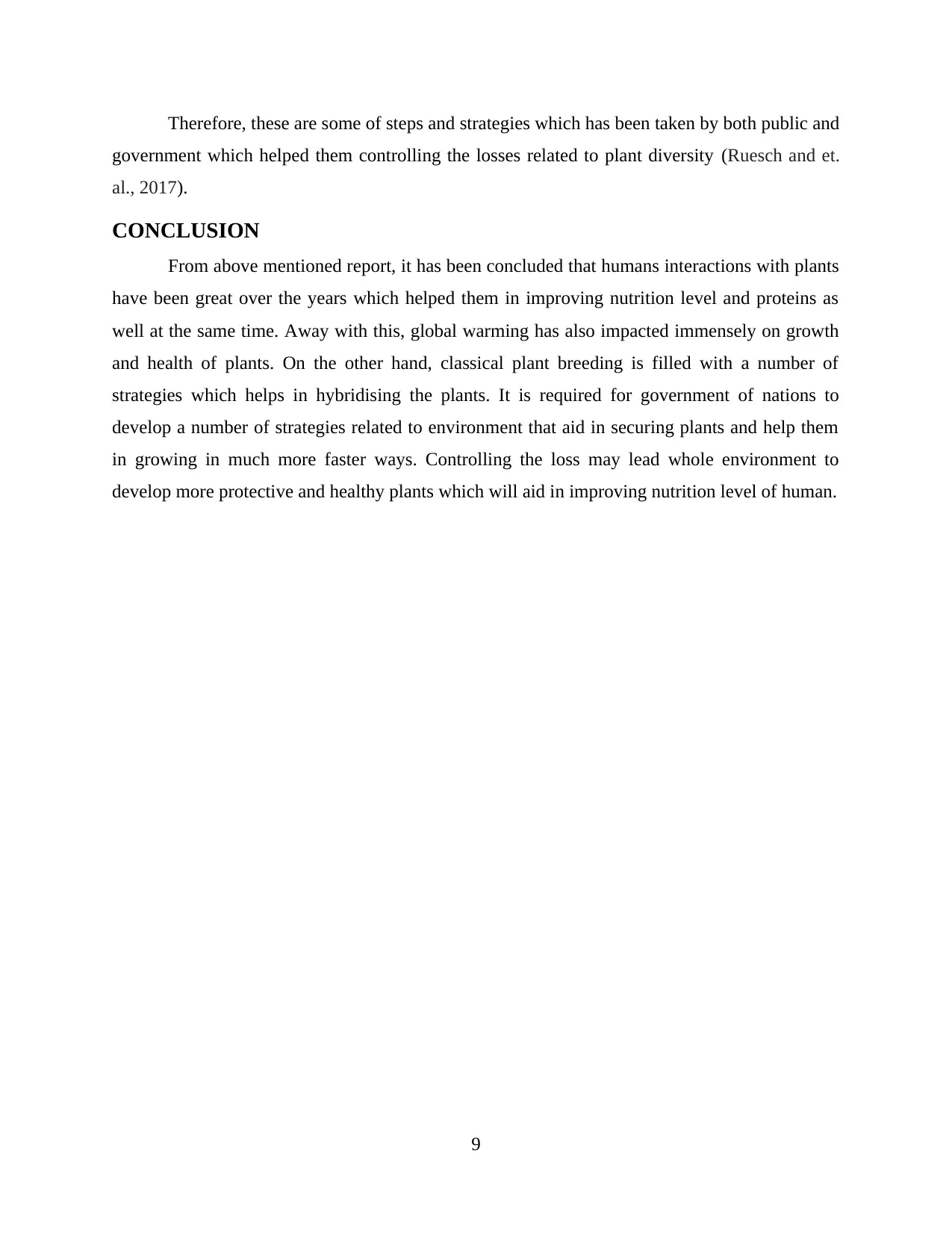
Therefore, these are some of steps and strategies which has been taken by both public and
government which helped them controlling the losses related to plant diversity (Ruesch and et.
al., 2017).
CONCLUSION
From above mentioned report, it has been concluded that humans interactions with plants
have been great over the years which helped them in improving nutrition level and proteins as
well at the same time. Away with this, global warming has also impacted immensely on growth
and health of plants. On the other hand, classical plant breeding is filled with a number of
strategies which helps in hybridising the plants. It is required for government of nations to
develop a number of strategies related to environment that aid in securing plants and help them
in growing in much more faster ways. Controlling the loss may lead whole environment to
develop more protective and healthy plants which will aid in improving nutrition level of human.
9
government which helped them controlling the losses related to plant diversity (Ruesch and et.
al., 2017).
CONCLUSION
From above mentioned report, it has been concluded that humans interactions with plants
have been great over the years which helped them in improving nutrition level and proteins as
well at the same time. Away with this, global warming has also impacted immensely on growth
and health of plants. On the other hand, classical plant breeding is filled with a number of
strategies which helps in hybridising the plants. It is required for government of nations to
develop a number of strategies related to environment that aid in securing plants and help them
in growing in much more faster ways. Controlling the loss may lead whole environment to
develop more protective and healthy plants which will aid in improving nutrition level of human.
9
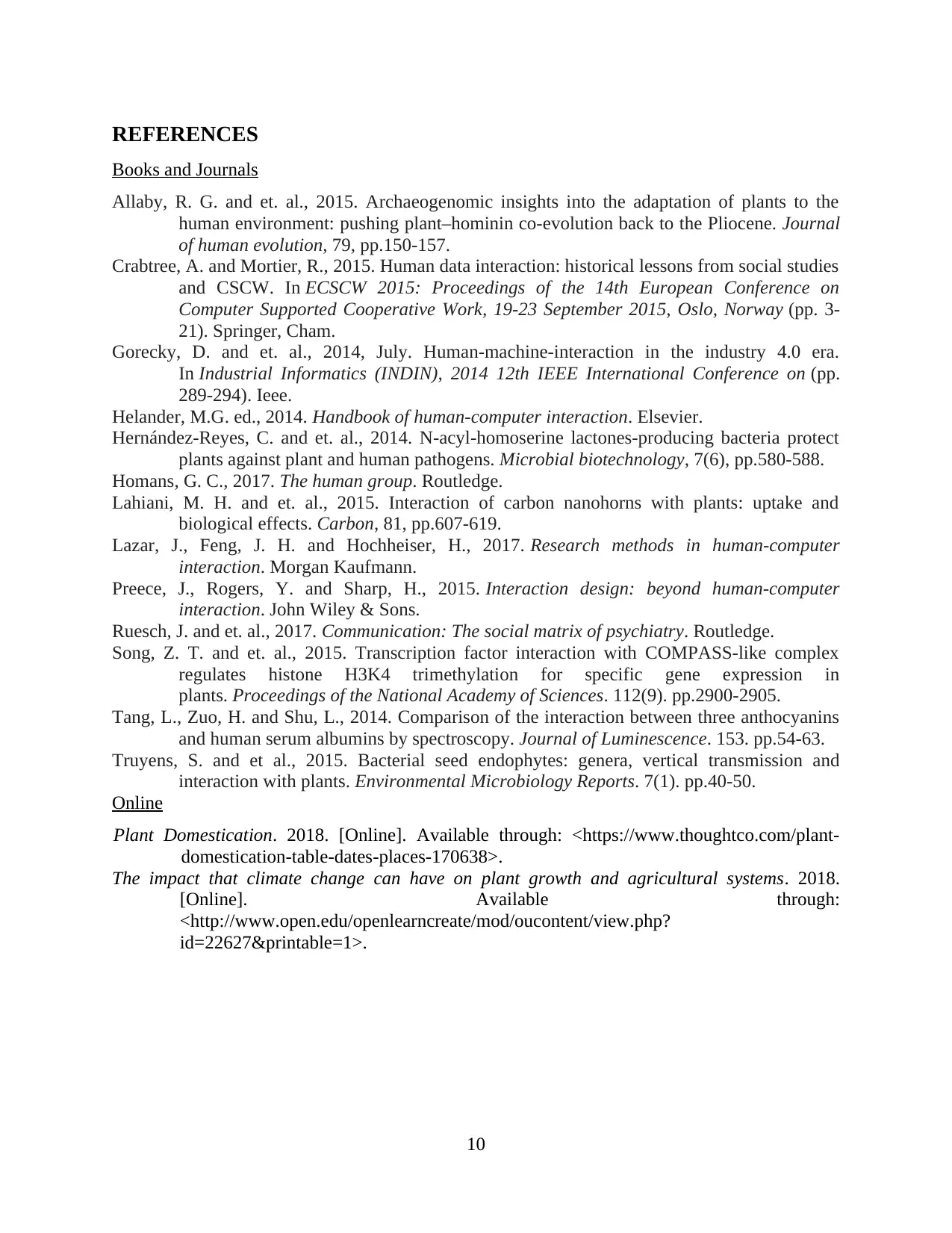
REFERENCES
Books and Journals
Allaby, R. G. and et. al., 2015. Archaeogenomic insights into the adaptation of plants to the
human environment: pushing plant–hominin co-evolution back to the Pliocene. Journal
of human evolution, 79, pp.150-157.
Crabtree, A. and Mortier, R., 2015. Human data interaction: historical lessons from social studies
and CSCW. In ECSCW 2015: Proceedings of the 14th European Conference on
Computer Supported Cooperative Work, 19-23 September 2015, Oslo, Norway (pp. 3-
21). Springer, Cham.
Gorecky, D. and et. al., 2014, July. Human-machine-interaction in the industry 4.0 era.
In Industrial Informatics (INDIN), 2014 12th IEEE International Conference on (pp.
289-294). Ieee.
Helander, M.G. ed., 2014. Handbook of human-computer interaction. Elsevier.
Hernández‐Reyes, C. and et. al., 2014. N‐acyl‐homoserine lactones‐producing bacteria protect
plants against plant and human pathogens. Microbial biotechnology, 7(6), pp.580-588.
Homans, G. C., 2017. The human group. Routledge.
Lahiani, M. H. and et. al., 2015. Interaction of carbon nanohorns with plants: uptake and
biological effects. Carbon, 81, pp.607-619.
Lazar, J., Feng, J. H. and Hochheiser, H., 2017. Research methods in human-computer
interaction. Morgan Kaufmann.
Preece, J., Rogers, Y. and Sharp, H., 2015. Interaction design: beyond human-computer
interaction. John Wiley & Sons.
Ruesch, J. and et. al., 2017. Communication: The social matrix of psychiatry. Routledge.
Song, Z. T. and et. al., 2015. Transcription factor interaction with COMPASS-like complex
regulates histone H3K4 trimethylation for specific gene expression in
plants. Proceedings of the National Academy of Sciences. 112(9). pp.2900-2905.
Tang, L., Zuo, H. and Shu, L., 2014. Comparison of the interaction between three anthocyanins
and human serum albumins by spectroscopy. Journal of Luminescence. 153. pp.54-63.
Truyens, S. and et al., 2015. Bacterial seed endophytes: genera, vertical transmission and
interaction with plants. Environmental Microbiology Reports. 7(1). pp.40-50.
Online
Plant Domestication. 2018. [Online]. Available through: <https://www.thoughtco.com/plant-
domestication-table-dates-places-170638>.
The impact that climate change can have on plant growth and agricultural systems. 2018.
[Online]. Available through:
<http://www.open.edu/openlearncreate/mod/oucontent/view.php?
id=22627&printable=1>.
10
Books and Journals
Allaby, R. G. and et. al., 2015. Archaeogenomic insights into the adaptation of plants to the
human environment: pushing plant–hominin co-evolution back to the Pliocene. Journal
of human evolution, 79, pp.150-157.
Crabtree, A. and Mortier, R., 2015. Human data interaction: historical lessons from social studies
and CSCW. In ECSCW 2015: Proceedings of the 14th European Conference on
Computer Supported Cooperative Work, 19-23 September 2015, Oslo, Norway (pp. 3-
21). Springer, Cham.
Gorecky, D. and et. al., 2014, July. Human-machine-interaction in the industry 4.0 era.
In Industrial Informatics (INDIN), 2014 12th IEEE International Conference on (pp.
289-294). Ieee.
Helander, M.G. ed., 2014. Handbook of human-computer interaction. Elsevier.
Hernández‐Reyes, C. and et. al., 2014. N‐acyl‐homoserine lactones‐producing bacteria protect
plants against plant and human pathogens. Microbial biotechnology, 7(6), pp.580-588.
Homans, G. C., 2017. The human group. Routledge.
Lahiani, M. H. and et. al., 2015. Interaction of carbon nanohorns with plants: uptake and
biological effects. Carbon, 81, pp.607-619.
Lazar, J., Feng, J. H. and Hochheiser, H., 2017. Research methods in human-computer
interaction. Morgan Kaufmann.
Preece, J., Rogers, Y. and Sharp, H., 2015. Interaction design: beyond human-computer
interaction. John Wiley & Sons.
Ruesch, J. and et. al., 2017. Communication: The social matrix of psychiatry. Routledge.
Song, Z. T. and et. al., 2015. Transcription factor interaction with COMPASS-like complex
regulates histone H3K4 trimethylation for specific gene expression in
plants. Proceedings of the National Academy of Sciences. 112(9). pp.2900-2905.
Tang, L., Zuo, H. and Shu, L., 2014. Comparison of the interaction between three anthocyanins
and human serum albumins by spectroscopy. Journal of Luminescence. 153. pp.54-63.
Truyens, S. and et al., 2015. Bacterial seed endophytes: genera, vertical transmission and
interaction with plants. Environmental Microbiology Reports. 7(1). pp.40-50.
Online
Plant Domestication. 2018. [Online]. Available through: <https://www.thoughtco.com/plant-
domestication-table-dates-places-170638>.
The impact that climate change can have on plant growth and agricultural systems. 2018.
[Online]. Available through:
<http://www.open.edu/openlearncreate/mod/oucontent/view.php?
id=22627&printable=1>.
10
⊘ This is a preview!⊘
Do you want full access?
Subscribe today to unlock all pages.

Trusted by 1+ million students worldwide
1 out of 12
Your All-in-One AI-Powered Toolkit for Academic Success.
+13062052269
info@desklib.com
Available 24*7 on WhatsApp / Email
![[object Object]](/_next/static/media/star-bottom.7253800d.svg)
Unlock your academic potential
Copyright © 2020–2025 A2Z Services. All Rights Reserved. Developed and managed by ZUCOL.